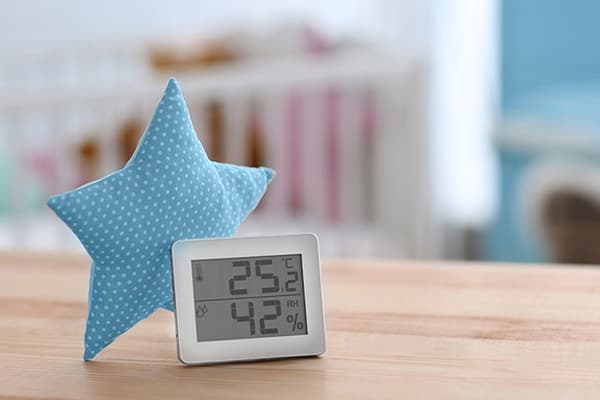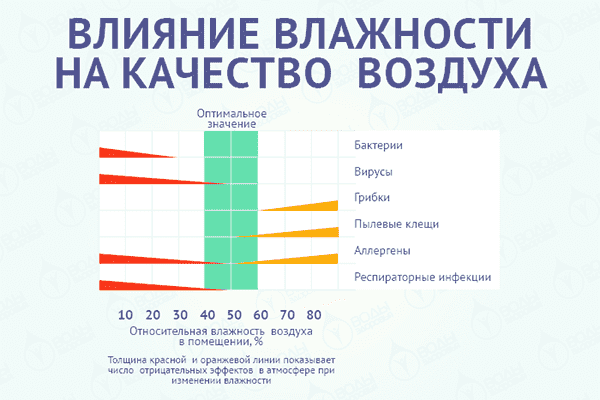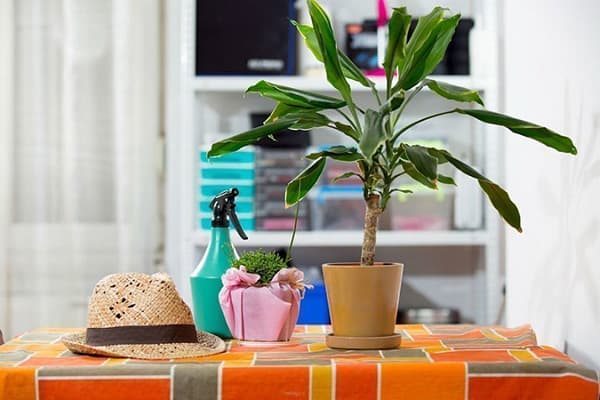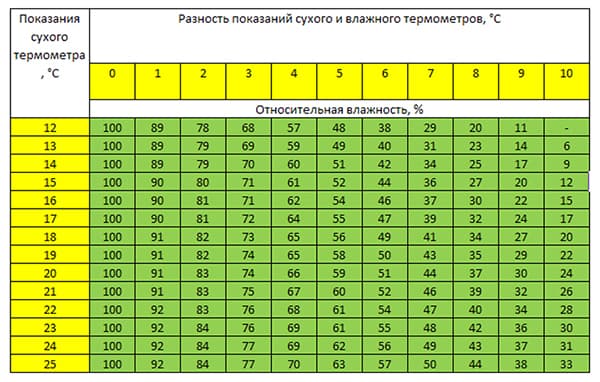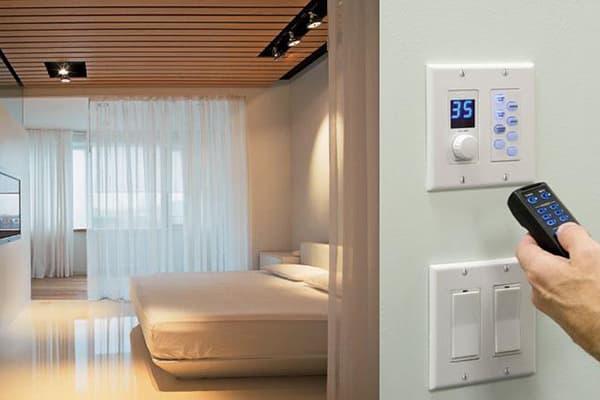What humidity is considered normal for an apartment and how to achieve the desired performance?
Content:
The amount of water vapor is an important indicator of a healthy indoor climate. Today, when more and more attention is paid to a healthy lifestyle, strengthening immunity, and the prevention of possible diseases, the relevance of the air humidity indicator is increasing. What are the norms of humidity in the apartment? What does it affect and how to influence it?
What humidity should be in the house?
There are 2 types of moisture measurement: absolute and relative.
- Absolute reflects the water content in the air (grams per cubic meter).
- Relative - the percentage of the recorded amount of moisture and the maximum possible at a specific temperature.
The norm of humidity in the apartment is a relative value. It can significantly affect all living things in the room (people, animals, plants), as well as the state of furniture, coatings, household appliances.
The average norm is a value from 40 to 60%. More specifically, from 30 to 60% in the summer and from 30 to 45% in the winter. Allowable maximum, respectively - 65% and 60%.
Of particular importance is the humidity regime for those rooms where children or people with respiratory diseases are.
There are also norms for interior items, various plants: for furniture and household appliances - 40-60%, for books on shelves - from 30% to 65%, for different types of plants - from 40% to 95%.
If humidity is not normal
It happens that the humidity in the room is either increased or decreased. What is this fraught with?
Too dry air, first of all, leads to excessive loss of moisture by the human body. Problems may arise such as:
- dry skin;
- cracks, wrinkles, dermatitis;
- itching and redness of the eyes due to their increased dryness;
- weakness and increased load on the heart due to the slowed circulation of thickened blood;
- slowing digestion (gastric juice also becomes thicker);
- dullness and fragility of hair, nails;
- decreased immunity and frequent colds due to constant drying of the mucous membranes of the nasopharynx;
- exacerbation of allergies (in dry air, the concentration of allergens increases).
In a room that is too dry, furniture will dry out over time, plants may dry, paintings, wallpaper, linoleum may warp.
Too humid air is an excellent medium for the growth of bacteria. In addition to the fact that in such a room there is dampness and stuffiness, this can give rise to more serious problems:
- chronic respiratory diseases (runny nose, bronchitis, asthma);
- allergy to microorganisms;
- foul smell inside the room;
- the appearance of molds that can cause serious diseases (primarily respiratory tract), up to tuberculosis.
With increased humidity, furniture and decoration materials are deformed due to swelling, household appliances can rust and fail, plants begin to decay (especially those that like rare watering).
Room Humidity
The recommended humidity indicators for them vary depending on the type of premises and the environment in them.
- Living room.
Usually this is the most spacious room where most of the household spend their time. There are often many indoor plants, animals. The optimal value that meets their needs is 40-50%.
- Bedroom adults.
The necessary humidity for a healthy sleep and well-being during a night's rest is 40–55%. Moreover, it needs to be supported taking into account open windows, with which it is recommended to sleep.
- The bedroom of the child.
Children tend to freeze or overheat faster than adults, and their colds are more severe. Especially harmful dry air affects the condition of the newborn baby. For children, the recommended indicator of humidity is 50-60%.
- Study.
Usually there are many books, documents, office equipment. All this is demanding on humidity standards. Do not exceed the bar 30-40%.
- Kitchen, bathroom.
These are traditionally “wet” rooms due to the constant evaporation of water. For the bathroom, this is even useful: toxins and toxins are better removed from the body, the skin is moisturized. But in the kitchen, it is desirable to strive for a comfortable rate - 40-50%.
- Storeroom, utility room, hallway, laundry, boiler room.
For technical rooms and short-stay rooms of tenants, air humidity is not particularly significant.
- Winter Garden.
Here, moisture indicators should correspond to the species of plants. Different flowers have different requirements for air humidity.
How to check the humidity in the apartment?
The relative humidity level in a room can be measured in several ways, which differ in costs, the complexity of the measurement and the accuracy of the results. The most accurate way is with a special device, a hygrometer. Hygrometers are available in different types, but for home use the simplest ones are enough (they are often built into a thermometer or watch). To make measurements more accurate, it is important to place the device away from sources of heat and moisture.
The second option is to use the Assman table, which displays the values of the usual and “wet” methods for measuring air temperature. These values can be determined using a psychrometer. Or replace it with improvised means: an ordinary thermometer and a damp cloth. First, the air temperature in the room is measured, as usual, then the thermometer is wrapped with a wet rag and a second reading is taken after 5 minutes. Now we need to find the obtained values in the table — in the “wet” and “dry” columns. At their intersection will be the desired value of air humidity.
You can check the degree of moisture in the room in simpler ways: using a glass of water or a fir cone.
A glass of water is cooled on a shelf of the refrigerator to a temperature of 3-5 degrees. Then put for 5 minutes in a room away from heat sources. If during this time the condensate on the walls of the glass is completely dry - the humidity in the room is clearly very low. If nothing has changed - optimal. If trickles of water flow down the walls of the glass - too high.
A fir cone, having lain for some time in a room, can remain in its original form (humidity rate), can reveal scales (humidity is lowered) or close (humidity is high).
In rooms where deviations from the desired parameters can be critical (for example, in a nursery or in an asthmatic bedroom), try to measure the humidity with an instrument to see digital values, and not just the “many - small” result.
How to increase the humidity in the room?
If it turned out to be lower than the required value, you need to take possible measures to moisten the room. This problem is especially relevant in winter, when heating appliances additionally dry out the air.
There are many ways to increase humidity. The most non-laborious is the use of a special moisturizing device. He independently splits water into steam particles and sprays them indoors. But the acquisition of such a device can be costly for the family budget. As well as buying, for example, a large aquarium, decorative items with a humidification function (fountains, “weeping walls”, etc.).
In this case, you can use alternative methods:
- Arrange a lot of water tanks (pots, bowls, containers) on cabinets, shelves, nightstands, near heating appliances or directly on them. As evaporation, water must be added.
- Hang wet linen, towels, kitchen napkins on batteries. When dry, wet and hang again.
- Turn on the electric kettle or a small stove in the room and place a pot of water on it.
- Get more indoor plants. They are watered, sprayed, in addition, they themselves release moisture into the room. There is one minus: at night, plants emit a lot of carbon dioxide, so this method can not be used in bedrooms.
How to lower humidity?
Humidity can become high due to lack of ventilation, constant cooking (kitchen), even because of a leaking roof, water supply or plumbing system.
Accordingly, the task will be the opposite: “dry” the air. There are also several options. Again, the most “hassle-free” of them - the acquisition of air dryers, air conditioners, climate control systems. In non-ventilated rooms, the installation of quality hoods is mandatory. In other rooms, windows must have windows. Because as a very effective way to reduce humidity is a systematic ventilation.
On a sunny day, you should not close the curtains: the sun even dries through the window panes the air is no worse than the wind.
Also, in order to reduce humidity, it is necessary to timely eliminate leaks in pipes and plumbing, refuse to dry clothes in the room, install an aquarium or flower pots in it.
So, an unequivocal answer to the question of what humidity is normal for a living room does not exist: depending on the functional, this value can fluctuate, but it does not always actually correspond to the required values. Although you need to strive for them. It is possible to measure this indicator of a microclimate in different ways. There are also many ways to bring it to the right level - to reduce or increase it. Maintaining the parameter within normal limits, we protect the health of our family and pets, as well as extend the life of furniture, books, home decoration and household appliances.
